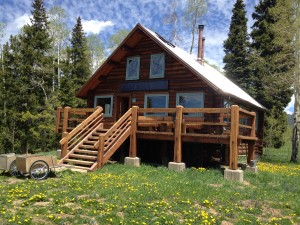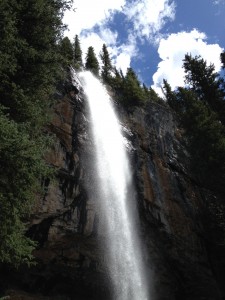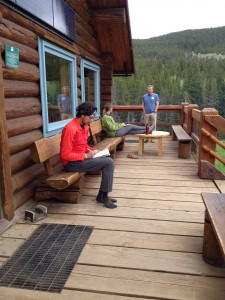
Colorado is famous for its backcountry huts. There’s a collection of them strewn across the mountains. Backcountry skiers can make tracks in and stay put for a weekend or ski hut-to-hut, building a fire in each woodstove and sleeping comfortably in an attic bunk after a long day out in the cold.
In June, there were still patches of snow above 10,000 feet in the Sawatch Mountains near Aspen, and the ground was covered instead with larkspur and bluebells. Spring had sprung in the meltwater and instead of skiing in, a group of adventure travel writers and bloggers piled into 4-wheel-drive vehicles and low-geared it through the mud to the wilderness barrier around the Harry Gates Hut. From the makeshift parking lot it was a slippery half mile hike to the hut itself and everything for the 3-day press trip had to be carried on our backs or pushed in wheelbarrow-like handcarts.
Aspen Alpine Guides specializes in winter hut trips, but they also offer off-season trips for backcountry marathon training, trail running, guided mountain and rock climbing expeditions and female-only wilderness trips as part of their “Leave the Boys Behind” program. An extremely wet May meant that the mud was a serious obstacle in early June. Most of the “regular” off-season trips would depart later in the summer when things had a chance to dry out a bit.

The travel writers were paving the way because they were already in the Aspen / Snowmass area for AdventureELEVATE, an ATTA event that introduced the media to primarily North America-based adventure travel tour operators and destinations. The trip was arranged by Carly Holbrook from the Colorado Tourism Office and Maureen Poschman representing the Aspen Chamber. After a professional conference, it’s always good to get out and actually do the things you’ve been talking about for three days straight, so they invited us to hike to the hut that may or may not have been accessible that time of year. But they sweetened the deal by bringing along a chef and a masseuse. We may not have been able to shower for three days after walking through the mud, but we were going to eat well and do our best to relax our tired muscles.
To people on the outside, a press trip -- especially one that includes gourmet meals and massages -- might seem like an immersion experience in pampering, but often these trips are experimental offerings without many -- or sometimes any -- of the kinks worked out. Media on these trips end up feeling like something between royalty and guinea pigs. The small luxury touches on our hut trip were very much unexpected and certainly appreciated. “It's nice to be on the receiving end of such a nice and thoughtful experience,” said Boulder-based travel writer Avery Stonich, proving that private chefs and spa treatments aren’t usually on the menu for press trips.
“Adding the extra customized elements like the chef and masseuse actually helped me sell my piece,” said Los Angeles-based writer Eric Hiss after the trip. “It elevated the experience, made it unexpected.” Because it’s not about how operators treat the writers themselves on the trip; it’s all about “the piece” -- the article that will come from the experience that will make it compelling or enticing to future travelers in an authentic way.
This is how press trips differ from advertising. Operators need to let the writer tell a true and personal story about the experience -- even if it’s rough around the edges, even if it rains the whole time, even if it means one of the most harrowing rides down a muddy mountainside a travel writer has ever experienced. Save the rosy images of your destination for your brochures. Let the media describe your destination in a relatable way that makes travelers want to book the next plane or next rough jeep ride to get there.

Of course the food was fantastic at the Harry Gates Hut and the massage very much appreciated after a high alpine hike through crumbling limestone to a waterfall. But this is not what made the press trip with Aspen Alpine Guides a success. We’ll never stop talking about the slow and slippery (and yes, scary) drive down the mountain after a 24-hour deluge threatened to wash out the road. As fresh in my mind as the afternoon snack of blinis with smoked trout, crème fraiche & chives and corn soup with whipped cream & tarragon is the willingness I felt to jump out of the car in thigh-deep mud and push my guide’s truck out of a ditch. I’m willing to recommend a wilderness trip with Aspen Alpine Guides not because of the hour-long deep tissue massage by the crackling woodstove, but because my guide Nate was willing to answer every single question I asked him about every single wildflower we encountered during the ten hours we hiked together.
“It goes without saying that guides are critical,” says Eric Hiss. “They need to not only be experts, but also personable and be able to handle lots of diverse personalities...and they should be prepared to answer sensitive questions like those related to environmental impacts etc. Guides should also be trained that if they don’t know something or it’s something they don’t feel comfortable answering, they can defer and say, ‘I will get back to you on that’ (and follow through!). Our Aspen Alpine Guides were fantastic.”
The writers from the hut trip agree on a few tips for tour operators about how to execute a great press trip:
- Get ready to answer our questions
Travel writers need a lot of detailed information that most of your guests won’t require of you. Be patient while we ask you to repeat things, to spell things, to show us on a map. Maureen Posch requested a copy of the menu from the chef and a list of where the ingredients were sourced for a food writer on the trip and that level of detail was valuable to everyone on the trip. (Read Amanda Rae’s “You Fancy, Huh? Simplicity Rules in the Wild” in the Aspen Times.) - Give us some options & some free time
Travel writers are often like that kid on a field trip who doesn’t have a buddy. We won’t hold anyone’s hand. We wander off. We do our own thing. We need to stray from the itinerary sometimes because our story depends on it. This is especially true of press trips. “This gives writers options to follow their unique story angles,” says Eric Hiss, “And it means the entire group won’t have exactly the same material, which can be a competitive challenge for us.” And “Build in some down time,” says Avery Stonich, “I have deadlines whether or not I'm on a FAM trip. I need some time in the day to attend to business.” - We’re special...but not that special
It’s fine to treat the press like VIPs. They really are in a lot of ways and you want to put your best foot forward as a company when you’re working with writers. But the experiences that we are going to be writing about need to be the kinds of experiences other travelers will have access to. Don’t let me write about how great the gourmet food was at a hut if other travelers will be cooking hot dogs over the fire because they don’t have the option of having a chef. “I've had many situations where operators organize these really cool experiences, but it's not really re-creatable for the average tourist and that makes it much harder to write about and tell people to go there,” says travel blogger Sherry Ott. “Ideally I want something I can link to where people can book and re-create that experience to some extent.” - Let us stay connected
As a blogger, connectivity is crucial for Sherry Ott. “Always have wifi access for the writers!” she says, “Even if this means renting a mifi device...Don't lose the opportunity to get real-time content out there in your social media channels.” Even traditional print writers will mention you in a tweet or on their personal Facebook page or tag you in an Instagram photo, so making sure they stay connected can mean big shout-outs for you before pen ever even meets paper. Of course a major exception is in a place like a backcountry hut in Colorado, where no one gets cell or internet service and there’s a focus on unplugging and enjoying nature. That said, Aspen Alpine Guides had a Delorme InReach device on the trip for emergencies and small Goal Zero solar chargers for us to keep using our phones for notes and photos. Because no one wants to unplug all the way! - Let us pay ...sometimes
Believe it or not, sometimes writers can’t take comped press trips. Please understand that our editors or publishers just won’t allow it. It’s not that we don’t like free trips, but sometimes it’s easier if there aren’t strings attached. Offering a press rate for trips means that we can still participate and write about your trip and you can still get paid. But don’t forget that sometimes we can take free trips, which we love to take as objective professionals.
